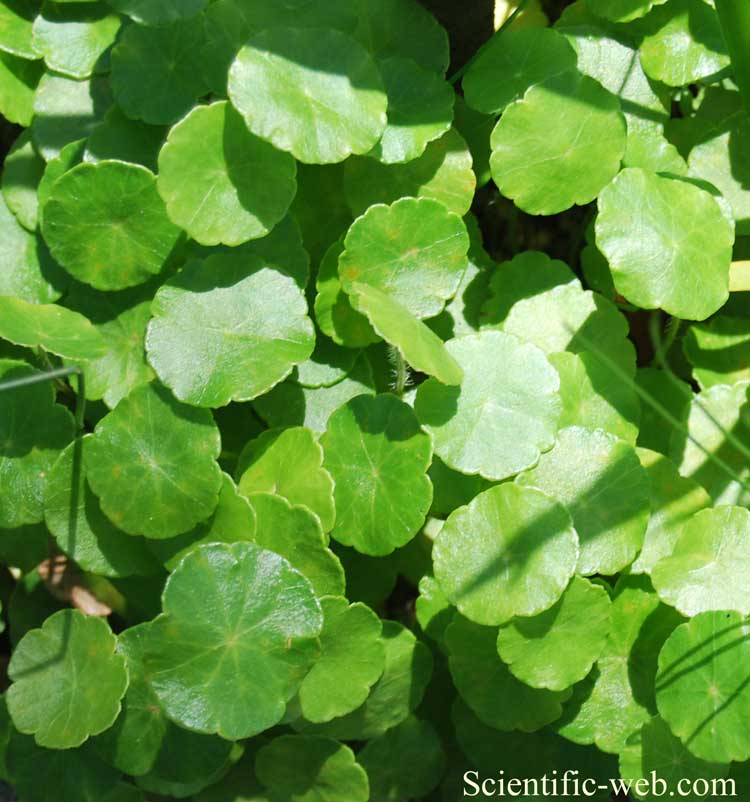
Hydrocotyle vulgaris, Photo: Michael Lahanas
Classification System: APG IV
Superregnum: Eukaryota
Regnum: Plantae
Cladus: Angiosperms
Cladus: Eudicots
Cladus: Core eudicots
Cladus: Asterids
Cladus: Campanulids
Ordo: Apiales
Familia: Araliaceae
Subfamilia: Hydrocotyloideae
Genus: Hydrocotyle
Species: Hydrocotyle vulgaris
Name
Hydrocotyle vulgaris L., 1753
Synonyms
Hydrocotyle peltata Salisb.
Hydrocotyle pleiantha Cesati
Hydrocotyle schkuhriana Rchb.
Hydrocotyle vulgaris var. microphylla Lange
Homonyms
Hydrocotyle vulgaris Bory ex A. Rich. = Hydrocotyle umbellata L.
Distribution
Native distribution areas:
Continental: Europe
Iceland, Albania, Austria, Belgium, +Luxembourg, England, Corsica, Czech Republic, Slovakia, Denmark, France, Germany, Greece, Crete, Ireland (incl. Northern Ireland), Switzerland, Netherlands, Spain, Hungary, Italy, Montenegro, Croatia, Portugal, Norway, Poland, C-European Russia, Ukraine, Belarus, Estonia, Latvia, +Lithuania, Sardinia, +Sicily, Sweden
Continental: Asie
Azerbaijan (Talysh), Georgia [Caucasus], Iran (N-Iran), Israel (coastal W-Israel, Rift Valley), Jordania
Continental: Africa
+Algeria, +Morocco, Azores (Sao Miguel Isl., Terceira, Sao Jorge, Pico, Faial, Flores Isl.)
References: Brummitt, R.K. 2001. TDWG – World Geographical Scheme for Recording Plant Distributions, 2nd Edition
References
Linnaeus, C. 1753. Species Plantarum. Tomus I: 234. Reference page.
Links
Hassler, M. 2018. Hydrocotyle vulgaris. World Plants: Synonymic Checklists of the Vascular Plants of the World In: Roskovh, Y., Abucay, L., Orrell, T., Nicolson, D., Bailly, N., Kirk, P., Bourgoin, T., DeWalt, R.E., Decock, W., De Wever, A., Nieukerken, E. van, Zarucchi, J. & Penev, L., eds. 2018. Species 2000 & ITIS Catalogue of Life. Published online. Accessed: 2018 Nov. 18. Reference page.
International Plant Names Index. 2018. Hydrocotyle vulgaris. Published online. Accessed: Nov. 18 2018.
The Plant List 2013. Hydrocotyle vulgaris in The Plant List Version 1.1. Published online. Accessed: 2018 Nov. 18.
Tropicos.org 2018. Hydrocotyle vulgaris. Missouri Botanical Garden. Published online. Accessed: 18 Nov. 2018.
USDA, ARS, Germplasm Resources Information Network. Hydrocotyle vulgaris in the Germplasm Resources Information Network (GRIN), U.S. Department of Agriculture Agricultural Research Service. Accessed: 09-Oct-10.
Vernacular names
беларуская: Шчыталіснік звычайны
Cebuano: Hydrocotyle vulgaris
čeština: pupečník obecný
Cymraeg: Dail-ceiniog y gors
dansk: Vandnavle
Deutsch: Gewöhnlicher Wassernabel, Wassernabel
English: marsh pennywort
español: Sombreret d´aygua, Hidrocótila, Sombrero de agua, Ombligo de Venus que nace en el agua, Sombrerillo de agua, Soldanela acuatica, Picante de ranas
eesti: Loim-vesipaunikas
فارسی: آب بشقاب معمولی
suomi: Viitasammakonputki
français: Hydrocotyle vulgaire, Écuelle d'eau
hornjoserbsce: Wšědny pupnik
日本語: ウチワゼニクサ, 団扇銭草, タテバチドメグサ, ウォーターマッシュルーム, ウチワゼニグサ
lietuvių: Pelkinė raistenė
Nederlands: Gewone waternavel
norsk nynorsk: Skjoldblad
norsk: Skjoldblad
polski: Wąkrota zwyczajna
slovenčina: pupkovník obyčajný
svenska: Spikblad
Winaray: Hydrocotyle vulgaris
中文: 野天胡荽
Hydrocotyle vulgaris, the marsh pennywort, common pennywort, water naval, money plant, lucky plant or copper coin,[2] is a small creeping aquatic perennial plant native to North Africa, Europe, the Caucasus and parts of the Levant.
Description
Shield-shaped leaf
The plant has an umbrella-like leaf and lives commonly in wet places such as wetlands, marshes and swamps, sometimes even in deeper water. It grows as a perennial herbaceous plant and only reaches stature heights of 5 to 20 centimeters. With a slight smell of carrot, it is edible.
This marsh plant forms numerous, up to 1 meter long, creeping offshoots. The serrated, rounded, shield-shaped leaves can have a diameter of up to 4 centimeters, but are often smaller. The approach of the long, hairy petioles is located in the middle of the leaf underside. The leaves are fresh green, shiny waxy and shows a clear, radially extending vein.
The tiny, inconspicuous, hermaphrodite flowers are in low-flowered doldigen? inflorescences or whorls, with the stems of the inflorescence about half as long as those of the leaves. The petals are greenish, white or reddish. The flowering period is from July to August. The fruits are flat, warty and winged.[3]
Cultivation
A low maintenance plant, it prefers to grow in reliably moist humus under a full sun or in part shade, indoors or outdoors, though it can tolerate full shade as well. It may also be grown as an aquatic plant in mud at the side of a pond or water garden in up to 2 inches of stagnant water. Despite its habitat in water, over-watering may still cause root rot.[4]
Population
The plant is distributed and plentiful throughout much of its range in Europe, North Africa and Western Asia. Nonetheless, it is classed as critically endangered in Croatia, vulnerable in Switzerland and near threatened in Norway. Furthermore, the plant is protected under regional legislation in France.[1]
Ecology
In Britain it is the only native Hydrocotyle, growing in wet places such as fens, swamps, bogs and marshes. For example, it is a component of purple moor grass and rush pastures – a type of Biodiversity Action Plan habitat. The flowers rarely bloom; mostly self-pollination takes place. Vegetative propagation occurs through foothills. In wild plant gardens, the marsh pennywort is used for the planting of garden ponds, and also as aquarium plant.[5]
See also
Umbilicus rupestris, a similar looking succulent
Pilea peperomioides, a similar looking rosales
References
Lansdown, R.V. (2014). "Hydrocotyle vulgaris". IUCN Red List of Threatened Species. 2014: e.T164201A42415437. doi:10.2305/IUCN.UK.2014-1.RLTS.T164201A42415437.en. Retrieved 12 November 2021.
BSBI List 2007 (xls). Botanical Society of Britain and Ireland. Archived from the original (xls) on 2015-06-26. Retrieved 2014-10-17.
Siegmund Seybold (ed.): Schmeil-Fitschen interactive . CD-ROM version 1.1. Quelle & Meyer, Wiebelsheim 2002, ISBN 3-494-01327-6 .
Christel Kasselmann: Aquarienpflanzen. Ulmer Verlag, Stuttgart 1995; 2., überarbeitete und erweiterte Auflage 1999, ISBN 3-8001-7454-5, S. 306.
Manfred A. Fischer, Wolfgang Adler, Karl Oswald: Excursion flora for Austria, Liechtenstein and South Tyrol . 2nd, improved and extended edition. Upper Austria, Biology Center of the Upper Austrian Provincial Museums, Linz 2005, ISBN 3-85474-140-5 .
Retrieved from "http://en.wikipedia.org/"
All text is available under the terms of the GNU Free Documentation License

